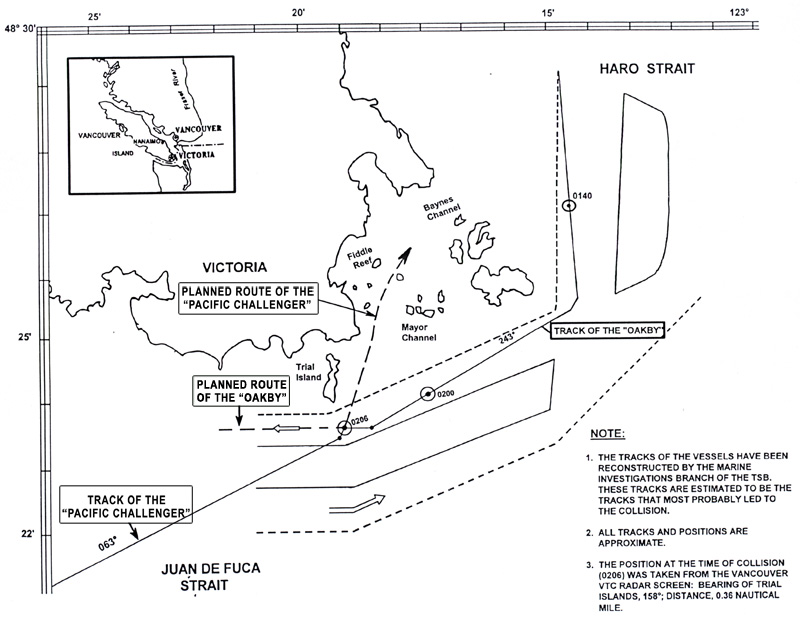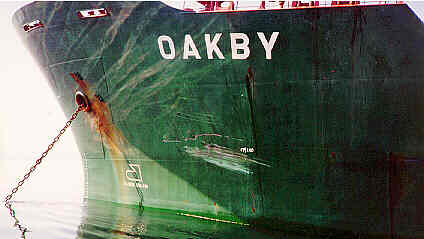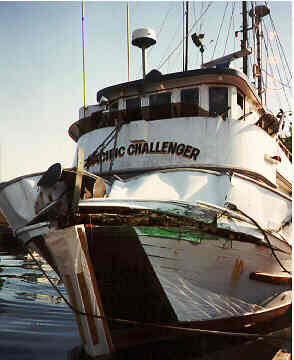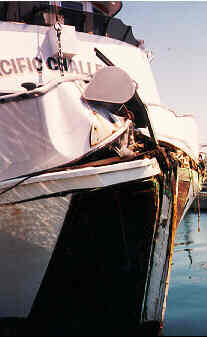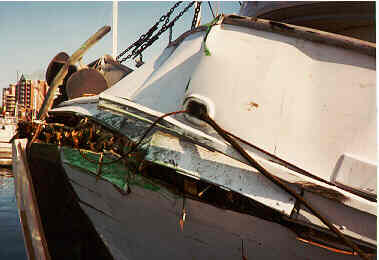Collision
between the bulk carrier "OAKBY"
and the seiner "PACIFIC CHALLENGER"
Juan de Fuca Strait, British Columbia
The Transportation Safety Board of Canada (TSB) investigated this occurrence for the purpose of advancing transportation safety. It is not the function of the Board to assign fault or determine civil or criminal liability. This report is not created for use in the context of legal, disciplinary or other proceedings. See Ownership and use of content.
Summary
On the night of 03/04 August 1993, the bulk carrier "OAKBY" was proceeding from Vancouver, British Columbia, to the Victoria pilot station to disembark her pilot. At the same time, a fleet of fishing vessels, including the "PACIFIC CHALLENGER", was inbound to Vancouver from fishing zone No. 20. The winds were calm and visibility was excellent. South of Trial Islands, both vessels altered course, one to starboard, the other to port, and they collided at 0206. No damage was reported by the "OAKBY". The "PACIFIC CHALLENGER" sustained substantial damage and one crew member was injured.
The Board determined that the "OAKBY";, which was aware of the presence of a fishing fleet in the area, was making excessive speed in the circumstances. The watch on the "PACIFIC CHALLENGER" was ineffective; speed was not reduced and no action was taken to avert a close-quarters situation. Neither vessel took corrective action in sufficient time to prevent the collision, and neither made any attempt to notify the other of her intentions by radio, sound signals or visual signals.
A contributing factor in the collision was that the "PACIFIC CHALLENGER" was proceeding against the general direction of traffic flow in the traffic separation scheme.
1.0 Factual Information
1.1 Particulars of the Vessels
| "OAKBY" | "PACIFIC CHALLENGER" | |
|---|---|---|
| Official number | 723169 | 347140 |
| Port of registry | Nassau, Bahamas | Vancouver, B.C.Footnote 1 |
| Flag | Bahamas | Canadian |
| Type | Bulk carrier | Fishing vessel |
| Gross TonsFootnote 2 | 35,603 | 61.1 |
| Length | 224.37 m | 17.43 m |
| Breadth | 32.26 m | 5.33 m |
| Depth | 18 m | 2.2 m |
| Draught | F: 11.74 m A: 11.75 m | F: 1.82 m A: 2.59 m |
| Crew | 24 | 5 |
| Built | 1983, Hyundai Heavy Industries Co. Ltd., Ulsan, Korea | 1973, Delta, B.C. |
| Propulsion | One B&W 2SA diesel engine capable of 10,666 kW, driving a fixed-pitch propeller | One Caterpillar diesel engine capable of 272 kW, driving a fixed-pitch propeller |
| Owners | Ropner Shipping Co. Ltd., Darlington, England | Jim Pattison Enterprises Ltd., Vancouver, B.C. |
1.1.1 Description of the Vessels
"PACIFIC CHALLENGER"
The "PACIFIC CHALLENGER" is a fishing vessel of a type commonly used on the West Coast, with the accommodation forward and the fishing gear aft. The service speed of the vessel is about eight knots and her stopping distance is about 40 m.
"OAKBY"
On the "OAKBY", the accommodation is located aft and there is no equipment on the deck which could impede visibility from the bridge. The service speed of the vessel is 14 knots.
1.2 History of the Voyage
On the night of 03/04 August 1993, the fishing vessel "PACIFIC CHALLENGER" was en route to the port of Vancouver, B.C., from a salmon "opening" in the Juan de Fuca Strait, and the bulk carrier "OAKBY" was outbound from the port of Vancouver's Westshore Terminal to the Victoria pilot station in the Juan de Fuca Strait. The "PACIFIC CHALLENGER", with a catch of some six tonnes of salmon, was one of a fleet of about 50 fishing vessels bound for Vancouver. The fishing vessels had left the zone No. 20 fishing grounds at the end of the "opening", at about 1900Footnote 3 on 03 August. The "OAKBY" had departed from the Westshore Terminal at 2234 on 03 August with a cargo of 50,113 tonnes of coal bound for Immingham in the U.K. Both vessels were proceeding within the Vancouver Vessel Traffic Services (VTS) zone, an area within which a traffic separation scheme has been established on major traffic routes.
The "PACIFIC CHALLENGER", being a vessel of not more than 20 metres in length, was not required to participate in the VTS system or use the traffic separation scheme routing system, and she was not taking part in either system. The "OAKBY" was required to participate in the VTS system and use the Strait of Juan de Fuca routing system and was complying with both requirements.
As the vessels closed, they were in the vicinity of a sector of the traffic separation scheme, some two miles east of the Victoria pilot station.
"PACIFIC CHALLENGER"
From Race Passage, some of the fishing vessels, including the "PACIFIC CHALLENGER", steered a course of approximately 063· to pass south of Trial Islands before turning to the north to pass through Mayor and Baynes channels to reach Haro Strait.
Shortly after 0200, 04 August 1993, the "PACIFIC CHALLENGER" was about half a nautical mile south of Staines Point, Trial Islands, making a speed of eight knots through the water. In this position, the vessel was in the westbound lane of the traffic separation scheme east of the Victoria pilot station.
The person who had the conduct of the vessel saw the two sidelights of a vessel almost dead ahead. The radar indicated that the other vessel was half a nautical mile distant. Using the autopilot, he altered course to port and steered toward Baynes Channel.
He altered course gradually while observing the other fishing vessels making the same manoeuvre. The vessels were sailing close together, and basically forming into a single file to make the passage at Fiddle Reef. This took up most of his attention and when he again looked toward the bulk carrier, he could see only her bow close in. An emergency manoeuvre was made, but it was too late to avert the collision.
"OAKBY"
The "OAKBY" rounded Discovery Island at about 0150 on 04 August, leaving Haro Strait and entering the Juan de Fuca Strait on the penultimate leg of her passage to the Victoria pilot station.
At approximately 0200, when the "OAKBY" began to meet the fishing fleet east of Trial Islands, she was on a course of 243·(T), and her speed was about 13 knots through the water. After crossing two fishing vessels, two more vessels were seen ahead, at a distance variously estimated at from half a mile to in excess of a mile and a half; they were fine on the starboard bow and showing their port sidelights. The order to alter course to starboard was given, and the bulk carrier began to turn to 270· to give the fishing vessels more sea room while, at the same time, heading for the pilot station.
With the "OAKBY" altering course, the fishing vessels were now on her port bow, and when they were seen to be showing their starboard sidelights, starboard helm was again ordered. Five short blasts on the whistle were sounded, but the collision could not be avoided.
The vessels collided at 0206 in approximate position 48·23'N, 123·18.5'W. The angle of impact was about 70 degrees. The port bow of the "PACIFIC CHALLENGER" struck the port bow of the "OAKBY".
1.3 Injuries to Persons
"PACIFIC CHALLENGER"
| Crew | Passengers | Others | Total | |
|---|---|---|---|---|
| Fatal | - | - | - | - |
| Missing | - | - | - | - |
| Serious | - | - | - | - |
| Minor | 1 | - | - | 1 |
| None | 4 | - | - | 4 |
| Total | 5 | - | - | 5 |
"OAKBY"
No injuries were reported on the "OAKBY".
1.4 Damage
1.4.1 Damage to the Vessels
"PACIFIC CHALLENGER"
The bow of the "PACIFIC CHALLENGER" sustained substantial damage. The bulwark and anchor were bent in the impact. The wooden structures of the foredeck and hull were broken in several places. The side planks were separated and damaged at the forward end.
"OAKBY"
The "OAKBY" sustained no damage except for a few scratches.
1.4.2 Environmental Damage
The accident caused no pollution or other environmental damage.
1.5 Certification
1.5.1 Vessels
"PACIFIC CHALLENGER"
The "PACIFIC CHALLENGER" was certificated, manned and equipped in accordance with existing regulations.
"OAKBY"
The "OAKBY" was certificated, manned and equipped in accordance with relevant regulations.
1.5.2 Personnel Certification
"PACIFIC CHALLENGER"
The skipper and the person who had the conduct of the "PACIFIC CHALLENGER" at the time of the accident held no certificates of competency, nor were they required to by regulation.
"OAKBY"
All members of the navigating personnel of the "OAKBY" held the required qualifications.
1.6 Personnel History
1.6.1 "PACIFIC CHALLENGER" Crew Members
The skipper of the "PACIFIC CHALLENGER" had worked on fishing vessels since 1971 and commanded this type of vessel since 1982. He assumed command of the "PACIFIC CHALLENGER" in 1992. The person who had the conduct of the vessel at the time of the collision had been employed on fishing vessels for 18 years, 10 of which on vessels similar to the "PACIFIC CHALLENGER" and 2 on the "PACIFIC CHALLENGER".
1.6.2 Master of the "OAKBY"
The master of the "OAKBY" began his mariner's career in 1954. He had served as master on various vessels since 1971. He assumed command of the "OAKBY" on 01 June 1993.
1.6.3 Pilot of the "OAKBY"
The pilot of the "OAKBY" held a pilot licence of the appropriate class and had been piloting in the district for 14 years.
1.7 The Juan de Fuca Traffic Separation Scheme
The conduct required of vessels using, and in the vicinity of, the Strait of Juan de Fuca traffic separation scheme is set out in Rule 10 of the International Regulations for Preventing Collisions at Sea (Colregs). The Canadian modifications specify that the traffic separation scheme shall be used by power-driven vessels of more than 20 metres in length. In part, Rule 10 requires that vessels crossing traffic lanes shall do so as nearly as practicable at right angles, that vessels of less than 20 metres in length shall not impede a vessel in a traffic lane, and that a vessel not using a scheme shall avoid it by a wide margin; fishing vessels are only exempted when fishing. The rule states that vessels of less than 20 metres in length may use"inshore traffic zones"; these are defined as areas between the traffic separation scheme and the coast intended for local traffic. Off Trial Islands, the landward boundary of the outbound lane of the traffic separation scheme is about one cable from the 10-metre depth contour.
A course line direct from Race Passage to Trial Islands crosses the outbound traffic lane to seaward of, and to the east of, the Victoria pilot station, on both occasions at an angle to, and opposing, outbound traffic over a distance of about one mile. The direct course line also runs through the two-mile radius boarding and disembarking station for the Pacific Pilotage Authority described in the Sailing Directions for British Columbia Coast (South Portion) published by the Department of Fisheries and Oceans.
1.8 Weather
At the time of the occurrence, the sea was calm, the winds were light, and visibility was excellent.
1.9 Radio Communications
1.9.1 Inter-Ship
The "PACIFIC CHALLENGER" was keeping radio watch on channels 16 and 78 of the very high frequency radiotelephone (VHF R/T). Channel 16 is the international calling and distress frequency and channel 78 is the frequency used by fishing vessel operators to communicate with one another. The fishing vessel was not required to monitor channel 11, the frequency used by the Vancouver Vesel Traffic Centre (VTC). Consequently, the "PACIFIC CHALLENGER" was not aware that a vessel was exiting Haro Strait and coming toward her until the "OAKBY" was detected visually or by radar.
As required by regulation, within the VTS zone, the "OAKBY" was keeping radio watch on VHF R/T channels 16 and 11.
Neither vessel attempted to communicate with the other when it became clear that a close-quarters situation was developing.
1.9.2 Vessel Traffic Centre (VTC) and Coast Guard Radio Station (CGRS)
"PACIFIC CHALLENGER"
The "PACIFIC CHALLENGER" had no radio contact with the Vancouver VTC or the Vancouver CGRS before the occurrence.
"OAKBY"
The "OAKBY" participated in the Vancouver vessel traffic routing system. The vessel's last contact with the VTC before the collision was at 0139 on channel 11 of the VHF R/T. At that time, the vessel had been informed by the VTC that a fleet of about 50 seiners was in the area, heading for Vancouver, and that none of these vessels participated in the Vancouver vessel traffic routing system.
1.10 Search and Rescue
On 04 August 1993, at 0208, the "PACIFIC CHALLENGER" reported to CGRS Vancouver by VHF R/T that she had been struck by a bulk carrier and was taking on water. The Victoria Rescue Co-ordination Centre was notified within one minute after this conversation.
No vessels were dispatched immediately because two fishing vessels, the "MISS CARMEN" and the "REBEL", were already alongside the damaged vessel. To prevent the vessel from sinking, the two fishing vessels that had come to her assistance tied themselves to either side of the "PACIFIC CHALLENGER".
At 0229, the "PACIFIC CHALLENGER" notified CGRS Vancouver that one crew member had been injured. The "AUXILIARY 35" was dispatched to the scene with medical personnel and a portable pump. She arrived 54 minutes later and returned to the wharf with the injured person at about 0357.
The "PACIFIC CHALLENGER" was escorted to Victoria by the two fishing vessels tied to either side of her.
The "OAKBY" was not damaged and did not require rescue services.
1.11 Composition of the Bridge Watch
"PACIFIC CHALLENGER"
The composition of the bridge watch on the "PACIFIC CHALLENGER" depends on the voyage being made. For the occurrence voyage, watches were assigned so as to require each member of the crew to be on duty for 3 hours and 15 minutes. This arrangement would have covered the total sailing time required for the return voyage. The only person in the wheel-house at the time of the accident was a fisherman's helper. He had had the conduct of the vessel since midnight.
"OAKBY"
The navigating personnel on the "OAKBY" comprised the master, the second officer, one helmsman and a pilot. The master and the pilot had been on the bridge since the vessel departed the terminal, and the second officer and helmsman had been there since midnight.
2.0 Analysis
2.1 Introduction
This analysis will concentrate on communications, and the bridge resource management on the vessels involved in the accident. Also considered will be the failure to sound the prescribed signals to avert collision and the course alterations made while the vessels were at close quarters. Special attention will also be given to the danger of commercial vessels heading for the Victoria pilot station meeting, and at times crossing, fishing vessels using Baynes Channel in a traffic separation scheme.
2.2 Radio Communications
Neither vessel could overhear any of the other's transmissions with respect to the conduct of the vessel or their intentions; their working channels were different, with the "PACIFIC CHALLENGER" monitoring a channel used by local fishing vessels and the "OAKBY" monitoring the VTS channel. Both the "OAKBY" and the "PACIFIC CHALLENGER" were, however, monitoring channel 16 and each vessel could have used that channel to initiate a call to the other vessel.
2.3 Sound Signals
Both vessels initiated alterations of course before the collision. A best reconstruction of events, based on testimony and the trace from the course recorder of the "OAKBY", indicates that the "OAKBY" began an alteration to starboard when the vessels were about one and a half miles apart and the "PACIFIC CHALLENGER" altered to port when the vessels had closed to less than half a mile. Both vessels initiated the course alteration without warning the other vessel by R/T, sound signals, or light signals. Signals by the vessels would have indicated the manoeuvre that each was initiating and, thus, could have prevented them from turning in the same direction.
A sound signal, consisting of five short blasts to indicate danger, was made by the "OAKBY" after the "PACIFIC CHALLENGER" was seen to alter course ahead of her.
2.4 Speed of the Vessels
The "OAKBY" maintained her service speed of about 14 knots until she slackened to a manoeuvring speed of about 13 knots a few minutes before the accident. That speed was not appropriate for the traffic conditions in the area she was entering. The vessel had been informed that a fleet of about 50 fishing vessels was proceeding toward Baynes Channel. The vessels were in sight, and the situation called for a great deal more caution.
Both vessels were moving on reciprocal routes at a combined speed of over 20 knots. Although additional starboard helm was applied by the "OAKBY" when the "PACIFIC CHALLENGER" was seen to alter course across her track, this could not prevent the collision.
2.5 Watch
Despite the good visibility, the bridge watch on the "PACIFIC CHALLENGER" only detected the presence of the "OAKBY" ahead when that vessel was half a mile distant. The approaching bulk carrier was in sight as soon as she rounded Discovery Island, ie. more than 15 minutes before the twovessels crossed. The attention of the bridge watch on the fishing vessel was mainly focused on the other fishing vessels that were close to and moving in the same direction. By the time the "OAKBY" was again noticed, collision was inevitable.
The course alteration by the "OAKBY" south of Trial Islands toward the Victoria pilot station should have been anticipated by the bridge watch on the fishing vessels. It is the normal course alteration required at that point for all vessels governed by the rules of navigation within the traffic separation scheme.
The bridge watch on the "OAKBY" had been informed by R/T that a fishing fleet was in the area. Many vessels were in sight and the bulk carrier had crossed some of them already. The course alteration by the fishing vessels also should have been anticipated by the navigating personnel on the bulk carrier. The pilots employed in these waters are aware that the fishing fleet regularly passes through Baynes Channel when returning to Vancouver after a day's fishing.
2.6 Traffic Separation Scheme
Because the landward boundary of the westbound traffic lane is close inshore at Trial Islands and the Sailing Directions recommend caution with respect to using the passage north of these islands, the inshore traffic zone is significantly restricted for traffic not using the traffic separation scheme between the Juan de Fuca Strait and Haro Strait. Vessels bound from Race Rocks to Baynes Channel and not using an inshore traffic zone must cross the traffic separation scheme at two points. However, in crossing the lanes at right angles, as required by the Colregs, it can be estimated that, for a vessel such as the "PACIFIC CHALLENGER", only two and a half to three miles, or some 20 minutes, is added to the inbound passage. Vessels following a direct course line, as the "PACIFIC CHALLENGER" did on this occasion, make an alteration of course off Trial Islands, in the same vicinity as outbound vessels using the traffic separation scheme alter course to head for the pilot station.
3.0 Findings
- A fleet of about 50 fishing vessels was proceeding inbound to Vancouver from the Juan de Fuca Strait.
- The fishing fleet did not participate in the Vancouver vessel traffic routing system.
- In this area of the Juan de Fuca Strait, the route used by the fishing vessels took them through the traffic separation scheme against the general direction of traffic flow for a distance of over two miles.
- Both vessels were monitoring channel 16 of the very high frequency radiotelephone (VHF R/T), but they were using different working frequencies for transmissions regarding the conduct and intentions of the vessel.
- The "OAKBY" was proceeding toward the Victoria pilot station.
- The bulk carrier maintained her service speed until she slackened to manoeuvring speed some six minutes before the collision.
- Prior to the collision, the two vessels were closing on reciprocal courses at a combined speed in excess of 20 knots.
- Neither vessel attempted to communicate with the other in any way, even when it became clear that a close-quarters situation was developing.
- Both vessels altered course prior to the collision and their headings were changing in the same direction as a close-quarters situation developed.
- Neither vessel gave sound signals or other signals to indicate her intention to alter course.
- The attention of the person who had the conduct of the "PACIFIC CHALLENGER" was diverted from the "OAKBY" as he manoeuvred his vessel within the fishing fleet.
- The collision occurred at an approximate angle of impact of 70 degrees, the port bow of the "PACIFIC CHALLENGER" striking the port bow of the "OAKBY".
- The "ACIFIC CHALLENGER" sustained considerable damage and one crew member was injured.
- Due to the lack of sea room, there is no inshore traffic zone south of Trial Islands.
3.1 Causes and contributing factors
The "OAKBY", which was aware of the presence of a fishing fleet in the area, was making excessive speed in the circumstances. The watch on the "PACIFIC CHALLENGER" was ineffective; speed was not reduced and no action was taken to avert a close-quarters situation. Neither vessel took corrective action in sufficient time to prevent the collision, and neither made any attempt to notify the other of her intentions by radio, sound signals or visual signals.
A contributing factor in the collision was that the "PACIFIC CHALLENGER" was proceeding against the general direction of traffic flow in the traffic separation scheme.
4.0 Safety Action
4.1 Safety Action Taken
4.1.1 Advisory Notice to Commercial Ships and Fishing Vessels
In June 1995, representatives of the Canadian Coast Guard, the Fisheries Council of British Columbia, the British Columbia Coast Pilots and the shipping industry met to discuss safety issues concerning commercial ships and fishing vessels on the West Coast. As a result, the 1995 Advisory Notice to Commercial Ships and Fishing Vessels Using the Inside Passage Waters of British Columbia During the Commercial Fishing Season was distributed to the industry and was also published in several industry publications including the Westcoast Fisherman, the Westcoast Mariner, and the union newspaper, The Fisherman. Fishing vessel operators are advised, inter alia, to monitor the Vessel Traffic Services (VTS) channel while in transit and to comply with the safety measures required by Rule 10 of the Collision Regulations when crossing or transiting a traffic separation scheme. Commercial ships are also advised, inter alia, to monitor channel 78A of the very high frequency radiotelephone (VHF R/T) in addition to the VST channel while transiting an open fishing ground.
This report concludes the Transportation Safety Board's investigation into this occurrence. Consequently, the Board, consisting of Chairperson, John W. Stants, and members Zita Brunet and Maurice Harquail, authorized the release of this report on .
Appendices
Appendix A - Sketch of the Occurrence Area
Appendix B - Photographs
Appendix C - Glossary
- A
- aft
- B.C.
- British Columbia
- CGRS
- Coast Guard Radio Station
- Colregs
- Regulations for preventing Collision at Sea
- F
- forward
- IMO
- International Maritime Oraganization
- knot
- nautical mile per hour
- kW
- kilowatt(s)
- m
- metre(s)
- N
- North
- PDT
- Pacific daylight time
- R/T
- radiotelephone
- SI
- International System of (units)
- T
- True (degrees)
- TSB
- Transportation Safety Board of Canada
- U.K.
- United Kingdom
- VHF
- very high frequency
- VTC
- Vessel Traffic Centre
- VTS
- Vessel Traffic Services
- W
- west
- °
- degree(s)
- ′
- minute(s)
